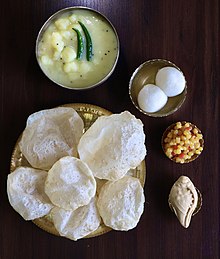 Luchi | |
| Type | Flatbread |
|---|---|
| Place of origin | Indian subcontinent |
| Region or state | India |
| Associated cuisine | India: Bhojpuri cuisine, Maithil cuisine, Odia cuisine, Assamese cuisine , Bengali Cuisine |
| Serving temperature | Hot |
| Main ingredients | Maida flour |
| Variations | Puri, Bhatoora |
Luchi (Bengali: লুচি, Odia: ଲୁଚି) or Lusi (Assamese: লুচি) or Luchui (Hindi: लुचुई or Luchai (Hindi: लुचई))[1][2] is a deep-fried flatbread, made of Maida flour.[3][4] Luchi is especially popular in the Indian states of Uttar Pradesh, Madhya Pradesh, Bihar, Assam, Odisha, West Bengal and Tripura and in the neighbouring country Bangladesh.
It is notably eaten with aloor dum or kosha mangsho. Since Luchi does not involve rice or rice flour, it is a popular staple item at times when rice is to be avoided,[5] as in the case of ekadashi, for those who believe in the ritual, or similar instances. In such ritualistic instances, since the primary food needs to be vegetarian, Luchi is preferred with dum aloo or any similar vegetarian dish. In occasions where no such restriction is mandated, luchi and kosha mangsho is often a popular combination.[6]





